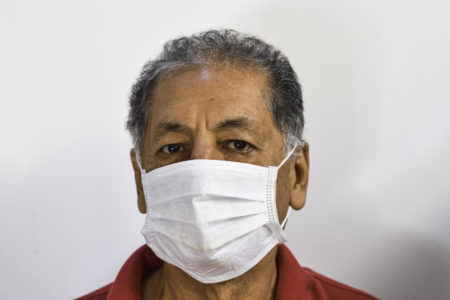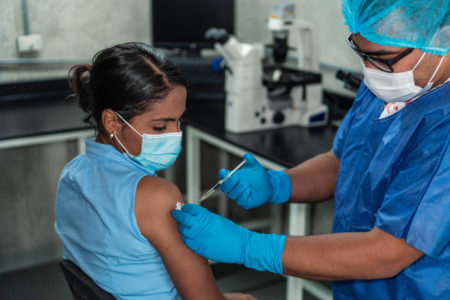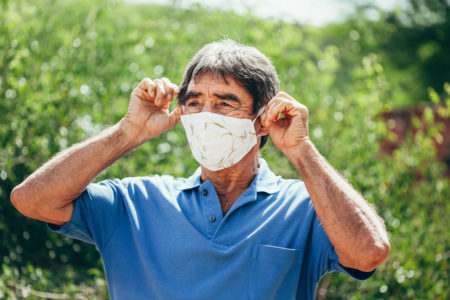
Share On Social!
COVID-19 has devastated the Latino community since the start of the pandemic.
As researchers gain more insight into the impact of COVID-19 over time, they’re finding Latinos continue to experience harsh impacts.
In fact, a recent study from the CDC shows that Latinos and other communities of color experienced higher rates of COVID-19 hospitalization than their white peers.
This is not just a symptom of COVID-19, but an issue of systemic injustice that needs dedicated action, according to CDC Director Dr. Rochelle Walensky.
“[There is a] critical need and an important opportunity to address health equity as a core element in all of our public health efforts,” Walensky said Monday during a White House Covid-19 briefing. “These disparities were not caused by the pandemic, but they were certainly exacerbated. The Covid-19 pandemic and its disproportional impact on communities of color is just the most recent and glaring example of health inequities that threaten the health of our nation.”
CDC Study and Its Findings on Latinos and COVID-19 Hospitalization
The CDC’s “Trends in Racial and Ethnic Disparities in COVID-19 Hospitalizations, by Region” analyzed data from March to December 2020.
The numbers didn’t look great for Latinos and other communities of color.
Initial findings showed that minority groups have experienced higher rates of COVID-19 hospitalization compared to their white peers. Moreover, Latinos experienced the highest rate of COVID-19 hospitalizations across ethnic groups.
“Analysis of hospitalizations from a database including more than 3.7 million hospital discharges and approximately 300,000 hospitalized COVID-19 patients found that racial and ethnic minority groups experienced higher proportions of COVID-19–related hospitalization compared with White patients,” the CDC study states. “This finding is consistent with previous studies documenting racial and ethnic disparities in COVID-19 hospitalization and expands upon earlier studies by documenting how these disparities have shifted over time and how they have differed by region.”
The height of COVID-19 hospitalizations for Latinos occurred from April to July 2020.
CDC researchers also found that countless disparities in hospitalizations remained throughout 2020 in all regions of the US. In the West, however, Latinos suffered the worst. 
This number shouldn’t be all that surprising, according to other datasets.
Many states are experiencing higher rates of COVID-19 cases and deaths among Latinos.
For example:
- Utah is 14% Latino. But they make up 20.5% of COVID-19 cases on April 3, 2021.
- Oregon is 13% Latino. But they make up 25.4% of COVID-19 cases on April 6.
- Washington is 13% Latino. But they make up 31% of COVID-19 cases on April 6.
- California is 39.3% Latino. But they make up 55.6% of COVID-19 cases on April 7.
18.7% of U.S. COVID-19 deaths are among Latinos, according to a new CDC data web page, “Health Disparities: Race and Hispanic Origin.” That page was updated April 14, 2021.
Vaccination disparities are happening, too.
As of April 19, 2021, 38 out of 50 states report a racial/ethnic breakdown of their COVID-19 vaccine distribution numbers that specify Hispanics/Latinos. All these states’ data show that Latinos are getting vaccinated at a much lower rate than their peers.
“[COVID-19] is robbing the Hispanic community of a generation of mothers and fathers and brothers and sisters,” Dr. Peter Hotez of Baylor College of Medicine told TPR.
What Is Behind COVID-19 Health Inequities among Latinos?
One factor influencing all of this?
Systemic, historic health inequities are behind COVID-19 and other disease disparities.
The pandemic has exacerbated social and health issues that, even before the pandemic, were making it harder to achieve health equity (where everyone has a fair, just opportunity to be their healthiest). This includes poverty, income and jobs, education, housing, transportation, air quality, and access to healthy food, green spaces, and health care. 
“Racial and ethnic disparities in COVID-19 hospitalization are driven by both a higher risk for exposure to [COVID-19] and a higher risk for severe COVID-19 disease (e.g., due to higher prevalence of underlying medical conditions) among racial and ethnic minority groups, both of which are influenced by social determinants of health,” the CDC study states.
What Can We Do About This?
More than anything, the disparities highlighted during the pandemic should be a top-priority focus of health officials.
“[The reports underscore] the need to address health inequities in our country, including and our vaccination efforts,” CDC’s Walensky said Monday during a White House Covid-19 briefing. “We must do better and we will do better.”
There are ways to step up, especially in your community.
According to the NIH’s Community Engagement Alliance (CEAL) Against COVID-19 Disparities, some ways to build community trust during the pandemic include invest in long-term relationships with community partners, listen to concerns and learn community insights, acknowledge research challenges and mistakes, and be transparent. 
A new study by NIMHD highlights how addressing misinformation and distrust through academic-community partnerships and creating community-engaged behavioral interventions can effectively address vaccine hesitancy and help promote equitable access to Latinos and other people of color.
For those looking to take action now, check out Salud America!’s guide to helping out!
Latinos suffer high rates of illness, hospitalizations, and death brought by COVID-19.
As Latinos, we are resilient. But part of our resiliency requires action, especially with the emergence of new COVID-19 vaccines.
Our team at Salud America! at UT Health San Antonio created this “Juntos, We Can Stop COVID-19” campaign in English and Spanish to help you─juntos/together─do your part to slow the spread of COVID-19. From skipping get-togethers with la familia to wearing a mask and physical distancing, we can reduce the spread of this raging virus.
And we can get the COVID19 vaccine, when available!
Explore More:
Overcoming Harmful BiasesBy The Numbers
3
Big Excuses
people use to justify discriminatory behavior



